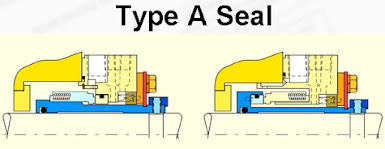Overview
• Overview of API 682 and ISO 21049
• Designed to introduce the user to some of the significant features of the standard
• Module 1 of a four part series
• Each Module has an accompanying text which can bee seen by viewing the Notes Page (View/Notes Page from the Menu bar)
• Overview of API 682 and ISO 21049
• Designed to introduce the user to some of the significant features of the standard
• Module 1 of a four part series
• Each Module has an accompanying text which can bee seen by viewing the Notes Page (View/Notes Page from the Menu bar)
Module 1 Topics
• Review of API 682 First Edition
• Mission Statement
• API 682 Second Edition
• ISO 21049 and API 682 Third Edition
• Scope of Standard
• Key Concepts
• Seal Types
• Seal Arrangements
• Categories
• Review of API 682 First Edition
• Mission Statement
• API 682 Second Edition
• ISO 21049 and API 682 Third Edition
• Scope of Standard
• Key Concepts
• Seal Types
• Seal Arrangements
• Categories
Mission Statement “This standard is designed to default to the equipment types most commonly supplied that have a high probability of meeting the objective of a least three years of uninterrupted service while complying with emissions regulations.”
Seal Types
• Over the years, seal companies have released numerous designs and variations
• No standardization in seal designs, materials, or dimensions
• Challenge for API 682 Task Force was to create standard seal types defining seal design, materials, installation envelope, and operating windows
• Rotating flexible element, multiple springs, O-ring secondaries
• Silicon Carbide versus premium grade blister resistant Carbon
• Fluoroelastomer O-rings (FKM)
• Alloy C276 springs (316 for single spring option)
• Type 316 SS sleeve, gland, and other metal parts
• Throttle bushing in gland
• Rotating bellows, O-ring secondaries
• Silicon Carbide versus premium grade blister resistant Carbon
• Fluoroelastomer O-rings (FKM)
• Alloy C-276 bellows
• Type 316 SS sleeve, gland, and other metal parts
• Throttle bushing in gland
• Stationary bellows, flexible graphite secondaries
• Silicon Carbide versus premium grade blister resistant Carbon
• Alloy 718 bellows
• Type 316 SS sleeve, gland, and other metal parts
• Premium carbon floating bushing in gland
• Bronze anti-coke device
Rotating vs Stationary
• The default Type A and Type B seals have a rotating flexible element
• A stationary flexible element is an alternate
• The default Type C seal has a stationary flexible element
• A rotating flexible element is an alternate
• If surface speed at the faces exceeds 4500ft/min (23 m/s), a stationary flexible element must be used
Seal Arrangements
• The seal arrangement defines the
number or seals, their orientation, and
details about the seal’s operation
• Designations
• Contacting wet (CW)
• Containment seals (CS)
• Non-contacting dry-running
• Contacting dry-running
• Non-contacting (NC)
• Wet running seals
• Dry-running dual seals
Contacting Wet Seal - CW
• “Typical” mechanical seal
• Mechanical seal designed to run on liquid fluid film
• Does not intentionally create hydrodynamic forces
• Requires vapor suppression to keep fluid in a liquid phase
• Designed to run for a minimum of 25,000 hours
• “Typical” mechanical seal
• Mechanical seal designed to run on liquid fluid film
• Does not intentionally create hydrodynamic forces
• Requires vapor suppression to keep fluid in a liquid phase
• Designed to run for a minimum of 25,000 hours
Containment Seal - CS
• Designed as a dry running backup seal
• Outer seal in a dual non-pressurized arrangement
• May be either a non-contacting or contacting design
• Operates on buffer gas or vaporized process fluid
• Run for 25,000 hours at 10 PSI and at least 8 hours under process conditions
• Designed as a dry running backup seal
• Outer seal in a dual non-pressurized arrangement
• May be either a non-contacting or contacting design
• Operates on buffer gas or vaporized process fluid
• Run for 25,000 hours at 10 PSI and at least 8 hours under process conditions
Non-Contacting Seal - NC
• May be used as a primary seal or as a dual pressurized seal
• Seal is designed to create hydrodynamic forces to separate the faces under all operating conditions
• Designed to run for a minimum of 25,000 hours
• 1CW-FX or 1CW-FL configuration
• Single mechanical seal
• May have a fixed or floating throttle bushing
• May have single point or distributed flush
• 2CW-CW configuration
• Dual non-pressurized seal with a liquid buffer fluid
• Same as the First Edition Arrangement 2 seal
• 2CW-CS configuration
• Contacting wet seal with a dry running containment seal
• Containment seal may be either contacting or non-contacting
• 2NC-CS configuration
• Inner seal is designed to be non-contacting and operate with liquid, vapor, or mixed phase process
• Outer seal a containment seal
• 3CW-FB configuration
• Contacting wet seals oriented in a series (or face-to-back) orientation
• Default Arrangement 3 liquid seal
• Same as the First Edition Arrangement 3 seal
• 3NC-BB configuration
• Default Arrangement 3 gas seal
• Non-contacting gas seals in a back-to-back orientation
Categories
• Different applications may require different levels of seal sophistication
• Current practice of specifying “modified” API-682 seals
• Size restrictions based on pump construction
• Cost impact of seals
Three categories
• Category 1 – General duty services in chemical pumps
• Category 2 – Heavy duty services; similar to API-610 7th edition seals
• Category 3 – Heavy duty services; similar to API 682 First Edition seals















